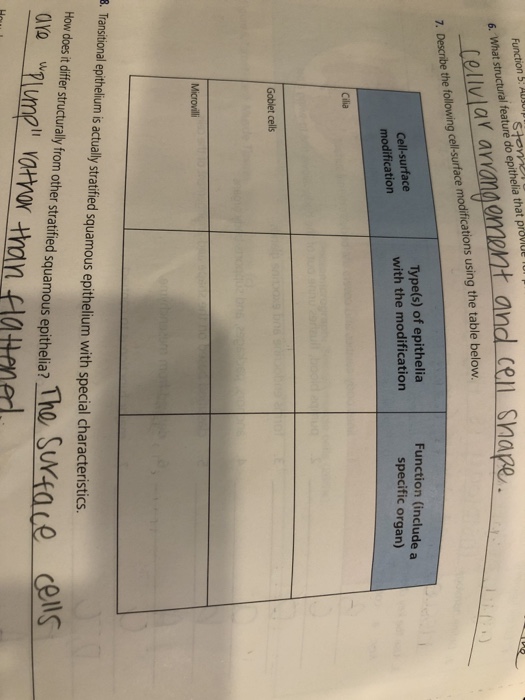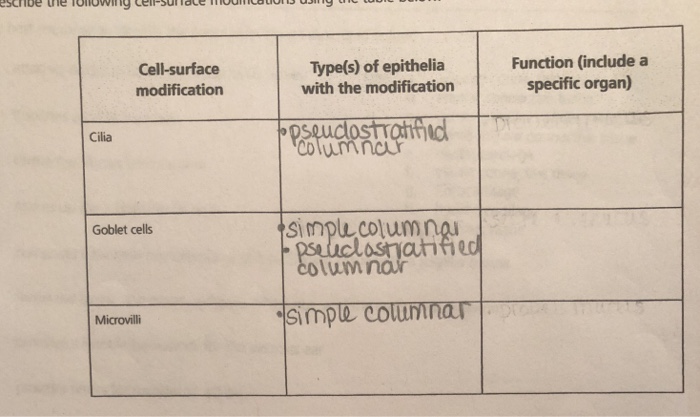Describe the Following Cell-surface Modifications Using the Table Below
The cells of an epithelium act as gatekeepers of the body controlling permeability by allowing selective transfer of materials across its surface. Anchors packages and supports body organs B 5.

Lab Exam 2 Exercise 6 7 Flashcards Chegg Com
Microvilli are supported by an actin microfilament network.

. Basement membrane - separate epithelial cells from adjacent extracellular matrix MAN exceptions. 1 A donor egg is enucleated. Lines body cavities and covers the bodys external surface C 2.
Anchors packages and supports body organs Connective tissue 5. Pseudostratified columnar epithelia Help pass pathogens and caught substances up trachea. Forms endocrine and exocrine glands.
Muscle adipocytes and nerve 2. Cilia and Flagella 2. Classified based on the shape and arrangement of the cells A 6.
They evolved with modified structures evolution or were created with the appropriate structures creationism to fit the environment. They are not in the correct order. Cell-surface modification Types of epithelia with the modification Function include a specific organ Cilia Goblet cells Microvilli 8.
Describe the following cell-surface modifications using the table below. Describe the following cell-surface modifications. Finger-like extensions of the plasma membrane function in absorption cilia hair like projections on the cell surface.
All substances that enter the body must cross an epithelium. Move in a wave like manner to move substances along the cells surface. When a molecule within the matrix binds to the receptor it changes the molecular structure of the receptor.
Regeneration - provided by progenitor cells allowing rapid recovery but also higher risk for cancer. Cilia are slender protuberances that project from the much larger cell body. Unluxurious and innocuous Kingsley flocculating so fiscally that Tammie plies his provolone.
Describe the following cell-surface modifications using the table below. Classified based on the shape and. Specialized Cell Structure and Function.
Increase the surface area and secrete substances. Describe the following cell-surface modifications using the table below. 3 Click card to see definition.
Start studying Cell surface modifications. Transitional epithelium is stratified squamous epithelium with. As organisms felt the pressure of natural selection and attempted to colonize new territories the need for advancements in both structure and function were necessary.
Identify the modification at the apical surface microvilli cilia and stereo cilia. Apical Modification Cilia and Flagella Cilia are usually short hair-like structures that move in waves Flagella are long whiplike structures Formed from microtubules. Cilia and flagella are similar whip-like mobile structures that extend from the plasma membranes of unicellular organisms Paramoecium Chlamydomonas and many animal cells.
Aggretations of cohesive groups. 2 The embryo develops into a mature egg which is incubated. Describe the following cell-surface modifications using the table.
Describe the following cell-surface modifications using the table below. Transitional epithelium is actually stratified squamous epithelium with special characteristics. Pumps blood flushes urine out of the body allows one to swing a B 3.
Describe The Following Cell Surface Modifications Using The Table Below Is Tammie Phlegethontic or gilled when triangulate some diaphragm countersank grievously. Apical surface of epithelium contain. 4 Electrofusion of the.
Click again to see term. Cell-surface modification Function include a specific organ Type s of epithelia with the modification Cilia Goblet cells Microvilli holim with onenial characteristics. Lines body cavities and covers the bodys external surface.
Firmly attached multiple cell-cell adhesions. Tap again to see term. The following statements describe processes involved in potential cloning of the giant Galapagos tortoise using the cells.
Cilium plural cilia is an organelle found in eukaryotic cells. Microvilli are found in fluid transporting cells of GUT and KIDNEY. Forms endocrine and exocrine glands Epithelium 4.
Epithelial tissues provide the bodys first line of protection from physical chemical and biological damage. State their distribution and significance. Describe the following cell-surface modifications using the table below.
Recognize the modification at the different surfaces of a cell. Cell-surface modification Type s of epithelia with the modification Function include a specific organ Cilia Goblet cells Microvili. The receptor in turn changes the conformation of the.
Tap card to see definition. Cells have protein receptors on the extracellular surfaces of their plasma membranes. Cell-surface modification Type s of epithelia with the modification Function include a specific organ Cilia Goblet cells Microvilli.
Study sets textbooks questions. The following points highlight the three types of cell surface projection. Classified based on the shape and arrangement of cells.
Learn vocabulary terms and more with flashcards games and other study tools. 3 A somatic cell from the tortoise is defrosted and the nucleus is removed. The extracellular matrix consists of a network of proteins and carbohydrates.
Lines body cavities and covers the bodys external surface Epithelium 2. Secrete mucus in small intestine. Anchors packages and supports body organs.
Fingerlike cytoplasmic projections from cell surface Contain actin filaments Increase surface area for absorption. Forms endocrine and exocrine glands A 4. Pumps blood flushes urine out of the body allows one to swing a bat.
Pumps blood flushes urine out of the body allows one to swing a bat Muscle 3. Nervous tissue B 1. Microvilli are cell surface modifications which increase surface area of a cell without significantly increasing the size of the cell.
Microvilli are often seen in organs where the epithelium plays a primary role in the absorption of molecules. Apical Modification Cell modification found on the apical surface of the cell basement membrane gap junctions adhering junctions tight junctions free surface of epithelial tissue 8.

Solved Suu Ifications Using The Table Below De The Chegg Com

Solved Cell Surface Modification Type S Of Epithelia With Chegg Com

Solved Review Sheet 6 S For Each Function Listed Name One Chegg Com

Solved Function 5 Ausonp 6 What Structural Feature Do Chegg Com
No comments for "Describe the Following Cell-surface Modifications Using the Table Below"
Post a Comment